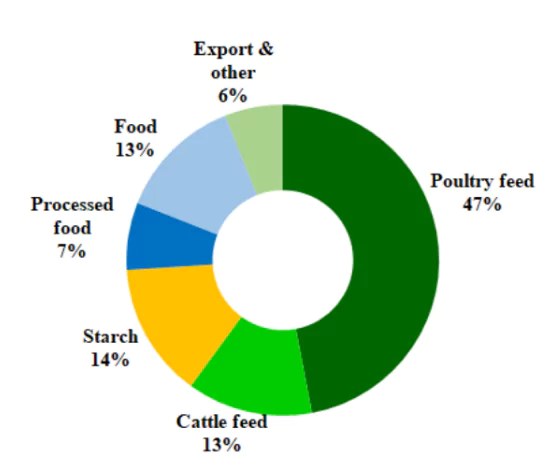India has recently become a net corn importer from being Asia’s top corn exporter due to rising demand for corn since its push to make more corn-based ethanol.
- The Year 2024: As per the Trade Ministry Data, India’s corn imports surged to 531,703 tons from just 4,981 tons a year earlier, while exports fell 87% from 1.8 million tons to 241,889 tons in the first half of the year.

Reason For The Rising Imports
- Incentivising Corn for Ethanol Production: The procurement price of ethanol made from corn was hiked in Jan 2024 to replace sugarcane-based ethanol for blending in gasoline
- In 2024 uptill now, around 3.5 million tons of corn has been used to make 1.35 billion litres of ethanol.
- Prioritize Domestic Sugar Consumption: The Government has suddenly curbed the use of sugarcane for ethanol following a drought thus leading to a shortfall of 5 million tons
- Squeezed Local Poultry Producers: India’s poultry producers demand removal of import duties and lifting of the ban on genetically modified (GM) corn as the prices of corn in the local market has risen affecting the feed cost.
- India allowed imports of around 500,000 tons at a concessional duty of 15% which usually attract a 50% import duty.
Enroll now for UPSC Online Course
Impact of India becoming a Net Importer
- Scrambling Global Supply Chains:
- Traditional export markets such as Vietnam, Bangladesh, Nepal, and Malaysia, are now compelled to source supplies from other countries
- Vietnam has cut down its imports of corn from India recently due to high prices in the Indian market
- Beneficiaries: The rising prices has benefited the exporters, farmers and other stakeholders in the supply chain
- New Markets: Starch makers are bringing in duty-free corn from Ukraine through India’s Advance License Scheme, under which an equal amount of finished goods must be exported.
- Support Global Prices: Indian Imports are likely to support global prices which are trading near four-year lows.
- Example: Indian demand has lifted corn prices in Myanmar to around $270 per metric ton, from around $220, encouraging farmers to plant more.
- Inflation in Corn: The major industries for corn (poultry and starch) are now battling with distilleries to secure supplies which is leading to a price rise due to increase in competition.
Check Out UPSC Modules From PW Store
About Corn/Maize
- Scientific name: Zea mays L.
- Native: Central America and Mexico
- Queen of Cereals: Maize is known as the queen of cereals because it has the highest genetic yield potential among the cereals.
- Types: It has many types like, normal yellow/ white grain, sweet corn, baby corn, popcorn, waxy corn, high amylase corn, high oil corn, quality protein maize, etc.
- Maize Production In India:
- India is the fifth largest producer of Maize in 2020 as per FAO data and India’s share in world production accounted for 2.59 per cent.
- Production: Corn accounts for approximately 10 percent of total food grain production in the country with Madhya Pradesh and Karnataka having the highest area under production (15% each) followed by Maharashtra (10%)
- Exports: The country has exported 3,453,680.58 MT of maize to the world in FY 2022-23 with major export destinations being, Bangladesh, Vietnam, Nepal, Malaysia and Sri Lanka.
 Usage: Usage:
- Staple Food Consumption: Maize in the form of Corn, Corn Flour etc is a source of Food for humans,
- Feed Stock: An estimated 60% goes as feed for poultry birds and livestock.
- Industrial use: 14-15% of India’s maize utilisation is for industrial purposes as it contains 68-72% starch which has its applications in the textile, paper, pharmaceutical, food and beverage industries.
- Feedstock for Ethanol: Maize is emerging as a feedstock for ethanol that is used for blending with petrol. Distilleries are considering the use of Maize to produce Ethanol in the off-season (May-October), when cane isn’t available.
|
About Ethanol
- Ethanol is anhydrous ethyl alcohol with the chemical formula C₂H₅OH.
- Sources: Ethanol can be made from plants with high starch content with multiple feedstocks, including sugarcane juice, molasses, damaged food grains, and agricultural residues
About Ethanol Blending Programme:
- Launch Date: The Ethanol Blending Programme started in January 2003.
- Objective: To promote the use of ethanol as an alternative fuel to conventional petrol.
- The E20 Target: India aims to increase the share of ethanol in gasoline to 20% by 2025-26, from the current 13% to curb carbon emissions.
- India needs more than 10 billion litres of ethanol, which is double the volume the country produced in the marketing year ended October 2023.
- Policy Support:
- Differential Ethanol Pricing: It aims to incentivise the ethanol production from various sources such as sugarcane juice, B heavy molasses, c-heavy molasses, grains etc.
- Interest Subvention Scheme: It is a government initiative that aims to offer relief by providing subsidized interest rates on loans to increase productivity.
- Regulatory amendments: Government allowed free movement of ethanol across various regions of India by doing amendments in the Industries (Development & Regulation) Act.
|
![]() 5 Sep 2024
5 Sep 2024

